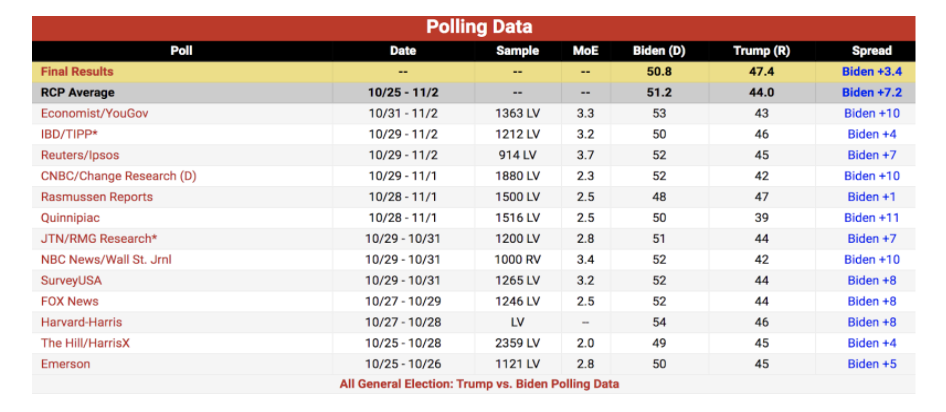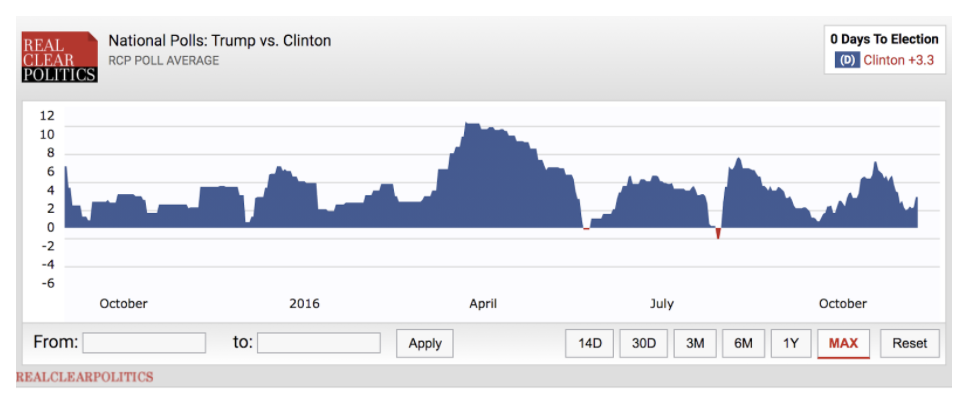|
It has been about two weeks since Former Vice President Joe Biden was elected to serve as the 46th President of the United States, crossing the 270 Electoral College threshold with a win in Pennsylvania. Throughout the race, the Biden and Trump campaigns worked to promote their message and vision for America in an effort to win over undecided voters and encourage more turnout. The COVID-19 pandemic prompted states to change their voting rules, presenting Americans with more options to vote, including mail-in ballots. As a result, nearly 160 million Americans are projected to have cast ballots in this election, which marks the highest voter turnout rate among eligible citizens since 1900. Democrats held the advantage in turnout for initial balloting, and early voting accounted for roughly 50% of the total votes counted in 2016 one week before November 3, as outlined by the figure below: While Democrats seemed more galvanized to vote early and by mail, Republicans led with in-person voting, an indicator that President Donald Trump’s unfounded claims over mail-in voting fraud resonated with many of his supporters. Most Republican voters were expected to vote in very large numbers in-person on Election Day, and the strong Democratic turnout added pressure to the GOP to mobilize its voters during the final stretch of the race. The month leading up to the election saw several new developments on the political and policy fronts. They followed the 2020 theme of uncertainty and surprise, as President Trump contracted COVID-19 after a White House event for the newly confirmed Supreme Court Justice Amy Coney Barrett. Despite his swift recovery from the virus, the event drew criticism over the lack of precautionary measures displayed by the White House and created a major setback for President Trump’s plans to hit the campaign trail and attend the second presidential debate. The final debate was a significant improvement from the first; both candidates appeared poised, sparring over several issues, including corruption allegations against the Former Vice President’s ties to foreign entities and President Trump’s tax returns. In addition, the Federal Bureau of Investigations issued a warning to the American people alerting them of election interference by foreign adversaries, such as Russia and Iran, through “suspicious email campaigns targeting elected officials.” The ongoing COVID-19 stimulus negotiations between the White House, House Democrats, and Senate Republicans failed to produce an agreement over a bill, as each side did not want to give the other a major legislative victory before the election. Senate Republicans did deliver a major win for the GOP with the confirmation of Justice Barrett to the Supreme Court, leading many Democrats to consider “court-packing.” Lastly, the presidential polls remained virtually unchanged up until Election Day, and they offered an imperfect snapshot into what occurred. Polling Data – National, Battlegrounds, and 2016 Comparisons The Real Clear Politics (RCP) average (chart below) showed a +7.2 advantage for Biden on November 2, but the final result was Biden +3.4, which reveals a much closer race and margin than anticipated. Biden’s dominance of the polls certainly lined up with the eventual favorable outcome for the Democratic nominee, but a new Berkeley Haas study found that most election polls report a 95% confidence level and the eventual result lines up with polling only 60% of the time. The analysis focuses on accounting for unknown variables or sources of inaccuracy that most pollsters often fail to consider, including last-minute changes in voter intentions, enthusiasm, and partisan non-response bias, a phenomenon that occurs when people who ignore pollsters possess very different traits from those who respond. Regardless of the unpredictability, history indicates that Biden held an unprecedented advantage for a challenger that late in the campaign. Only one other challenger - Bill Clinton in 1992- maintained a polling margin that wide leading up to Election Day since 1936, when scientific polling as first conducted during an election cycle. The RCP average for battleground states revealed a much closer polling gap between Trump and Biden, which painted a far more accurate snapshot into the final outcome. On average, Biden had a slight +2.3 lead in the top six battlegrounds (chart below), and the results have held with the exception of Florida, where Trump defeated his Democratic opponent on election night. In comparing the 2020 polls to 2016, Hillary Clinton was polling +3.3 on Election Day, or -3.9 than where Biden was polling (RCP figure below). There are a variety of factors at play that could explain why Biden’s lead was wider. First, the “October Surprise” of the emails reportedly found on Hunter Biden’s laptop that describe activities linking the Democratic nominee to a foreign intelligence operation may not have had the same effect that the release of the Comey letter had on Clinton in October 2016, assuming that this effect is measured by decreases in polling performance. Other potential factors could be that Democrats were more willing to respond to pollsters, or that many voters were shy to express their support for Trump because it is not the “socially desirable answer,” which leads to polling errors. The Cato Institute found that about 67% of Americans say that the political climate is too harsh that they would rather not reveal their true political opinions. Voters may have also been less willing to reward the incumbent for good performance on key issues like the economy due to other pressing priorities, including addressing the pandemic and racial injustice. Demographics and Enthusiasm The changing American electorate presented both campaigns with unique challenges during the 2020 race due to shifting demographics and coalitions among the American electorate. The Pew Research Center evaluated these new trends and the impacts on each party’s voting blocs. Highlights of their findings and analyses from other reports are below. Race
Enthusiasm Overall, enthusiasm and political engagement have been higher on average among Americans during this election cycle. One recent Gallup survey found that nearly 75% of Americans say they have “given their vote much thought.” When it comes to how strongly voters were backing their chosen candidate, 66% of Trump supporters said they support him strongly, while just 46% of Biden supporters said the same. The enthusiasm metric is something that President Trump has continued to highlight by pointing to the high turnout at his rallies. Biden’s campaign had less opportunities to show any of their backers’ enthusiasm, as they held events under social distancing guidelines. Excluding 2020, the winner held the enthusiasm advantage throughout the campaign three of the last five elections, including Trump in 2016. While Trump was unable to secure a victory off of enthusiasm, he managed to gain 7 million new voters during this election. Key Policy Priorities for Voters and Emerging Issues Analysis conducted by the Pew Research Center identified the top five priorities for voters in this election, which lead off with the economy, health care, Supreme Court appointments, COVID-19, and addressing violent crime. Democrats appear to have an edge on all except the economy, where most reports note that Republicans have the advantage. One point that drove recent political discussions was over the likelihood that the country would know who won the presidency on November 3rd. Both candidates were asked to voice their commitment to a peaceful transfer of power regardless of the outcome, and both President Trump and Democratic nominee Biden signaled that they would accept the results. Notably, a majority (68%) of American adults did not expect to know who won the presidency on Election Day, according to an NBC News tracking poll. They also held varying predictions on the timeline for when the country would learn the final outcome.
Delays over declaring the winner on November 3rd were likely due to the high volume of mail-in ballots, varying state laws over how to count them, and the tight margins. Battlegrounds like Pennsylvania did not begin counting early ballots until Election Day, taking them longer to process and verify. Other emerging issues that became a key focus on the campaign trail included “court-packing” and the politics of fracking. A recent Fox News poll reported that only 31% of likely voters favor packing the courts. The responses were mostly skewed based on political party, which likely reflects partisan attitudes toward the confirmation of Justice Barrett. When asked to publicly comment on the matter, Biden mentioned that he “may reveal his stance before Election Day.” On the issue of fracking, President Trump emphasized its importance during his rallies, especially when relaying his message with the Pennsylvania electorate. Despite his attempts to backtrack from statements made against the oil and gas industry during the primaries, Biden has yet to clearly communicate his stance on fracking, which the Trump campaign used to launch attacks, in an effort to secure the swing state into its win column. Pennsylvania, which won Biden the presidency, saw intense campaigning towards the end of the race, including three Trump rallies in one day, and ex-President Barack Obama delivered remarks on Biden’s behalf, highlighting its importance. The Paths to Victory Absent the success of court challenges filed by the Trump campaign in several states to contest the results in the election, Former Vice President Joe Biden and his running mate, Senator Kamala Harris (D-CA), will achieve a historic victory. Harris will be the first woman, first African-American and first South Asian-American to serve as Vice President. 270 electoral votes are needed to win the presidency, and Biden has already amassed 290 compared to Trump’s 217 after a victory in Alaska. Democrats successfully flipped Pennsylvania, Michigan, Wisconsin, and Arizona. Georgia and North Carolina remain uncalled, and Nevada showed a competitive race. Despite Biden’s victory, President Trump has not conceded, as his campaign continues to file lawsuits over voting fraud, irregularities with counting, and request recounts. Presidential polling throughout the race largely conveyed the narrative that Former Vice President Biden had a higher chance of winning the election, and they were correct, but not by as large of a margin as they projected. Recent content in the news cycle, including strong economic metrics and Biden’s link to his son’s foreign business dealings, may have altered the polls by influencing last-minute voters, but the margin appeared to be too formidable for the Republican incumbent to overcome. The whole year has been marked by simultaneous crises and political disruption, resulting in a deeply divided country over values and beliefs. To unify Americans, Democrats and Republicans presented their policies as the better path for the country’s direction. In the end, American voters ultimately decide which message offers a better vision for leadership, unity, and prosperity.
The views expressed above are solely the author's and are not endorsed by the Virginia Policy Review, The Frank Batten School of Leadership and Public Policy, or the University of Virginia. Although this organization has members who are University of Virginia students and may have University employees associated or engaged in its activities and affairs, the organization is not a part of or an agency of the University. It is a separate and independent organization which is responsible for and manages its own activities and affairs. The University does not direct, supervise or control the organization and is not responsible for the organization’s contracts, acts, or omissions.
0 Comments
Your comment will be posted after it is approved.
Leave a Reply. |
Categories
All
Archives
April 2022
|
ADDRESSVirginia Policy Review
235 McCormick Rd. Charlottesville, VA 22904 |
|
SOCIAL MEDIA |




